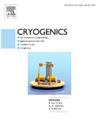Horizontal 1 K refrigerator with novel loading mechanism for polarized solid targets
IF 2.1
3区 工程技术
Q3 PHYSICS, APPLIED
引用次数: 0
Abstract
We describe a helium evaporation refrigerator used to cool dynamically polarized proton and deuteron targets for electron-scattering experiments using the CEBAF Large Acceptance Spectrometer CLAS12 at Jefferson Lab. The geometry of the CLAS12 detector systems places severe design and construction constraints on the refrigerator and its ancillary equipment, resulting in a horizontal cryostat with a length of 4 m. The 16 cm3 target samples, consisting of frozen ammonia (NH3 or ND3), are loaded at the upstream end of the cryostat and moved to the beam-interaction region using a novel transport mechanism. At this location they are cooled with superfluid helium and polarized via dynamic nuclear polarization at 1 K and 5 T. In this manner samples can be replaced and cooled to 1 K in about 30 minutes without disturbing any elements of the electron beam line or particle detection system. We estimate that this method saved 18 days of valuable beam time over the course of a recent, 88-day long experiment.
具有新型极化固体目标加载机构的水平1k制冷机
我们描述了一种氦蒸发制冷机,用于冷却动态极化质子和氘核目标,用于使用杰斐逊实验室的CEBAF大接受光谱仪CLAS12进行电子散射实验。CLAS12探测器系统的几何形状对制冷机及其附属设备的设计和构造有严格的限制,导致其长度为4米的水平低温恒温器。由冷冻氨(NH3或ND3)组成的16 cm3目标样品在低温恒温器的上游端加载,并通过一种新的传输机制移动到束流相互作用区。在这个位置,它们用超流氦冷却,并通过动态核极化在1k和5t下极化。这样,样品可以在大约30分钟内更换并冷却到1k,而不会干扰电子束线或粒子检测系统的任何元件。我们估计,在最近为期88天的实验过程中,这种方法节省了18天宝贵的光束时间。
本文章由计算机程序翻译,如有差异,请以英文原文为准。
求助全文
约1分钟内获得全文
求助全文
来源期刊

Cryogenics
物理-热力学
CiteScore
3.80
自引率
9.50%
发文量
0
审稿时长
2.1 months
期刊介绍:
Cryogenics is the world''s leading journal focusing on all aspects of cryoengineering and cryogenics. Papers published in Cryogenics cover a wide variety of subjects in low temperature engineering and research. Among the areas covered are:
- Applications of superconductivity: magnets, electronics, devices
- Superconductors and their properties
- Properties of materials: metals, alloys, composites, polymers, insulations
- New applications of cryogenic technology to processes, devices, machinery
- Refrigeration and liquefaction technology
- Thermodynamics
- Fluid properties and fluid mechanics
- Heat transfer
- Thermometry and measurement science
- Cryogenics in medicine
- Cryoelectronics
 求助内容:
求助内容: 应助结果提醒方式:
应助结果提醒方式:


